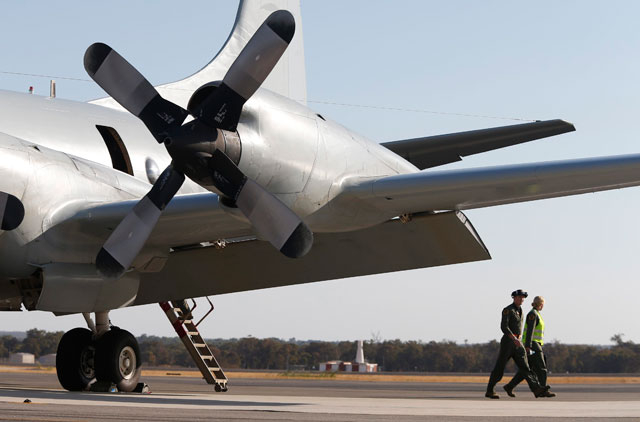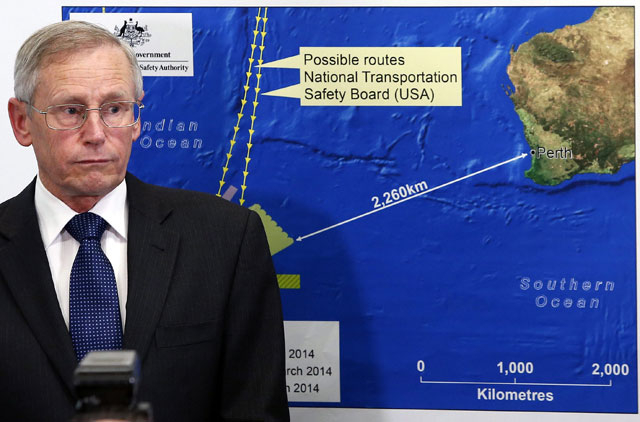
Kuala Lumpur: Spotter planes spent a second fruitless day scouring a remote stretch of the Indian Ocean for wreckage from a Malaysian jet Friday, as Chinese relatives of the missing passengers clashed with Malaysian officials.
Australian and US military aircraft usually used for anti-submarine operations criss-crossed the isolated search area 2,500 kilometres southwest of Perth, looking for two floating objects that had shown up on grainy satellite photos taken several days before.
Although the images were too indistinct to confirm as debris from Flight MH370, Australian and Malaysian officials said they represented the most "credible" leads to date in the hunt for the plane and its 239 passengers and crew.
Friday's search concluded "without any sightings", the Australian Maritime Safety Authority (AMSA) said in a statement.
The planes flew low under the cloud cover rather than rely on radar, after poor weather the day before hampered the search.
"We replanned the search to be visual, so aircraft flying relatively low, with very highly skilled observers looking out of the windows," said AMSA official John Young.
"This means aircraft operating more closely together and we will need more aircraft for this task."
Friday's aerial contingent comprised three Australian air force P-3 Orions, a US Navy P-8 Poseidon and a civil Bombardier Global Express jet.
The distance from the west coast of Australia allows the planes only about two hours of actual search time before they must turn around with enough fuel to get back to Perth.
Two merchant ships were helping with the search, but Australia's HMAS Success, which is capable of retrieving any wreckage, was still days away.
"This is going to be a long haul," Malaysian Transport Minister Hishammuddin Hussein told a daily press briefing in Kuala Lumpur.
Meanwhile, a delegation of Malaysian government and military officials flew to Beijing on Friday for what turned out to be a bad-tempered meeting with relatives.
The event began with family members yelling at delegates to stand up when they were being introduced.
"You have wasted so much time," shouted one.
The nature of the events that diverted MH370 from its intended flight path on March 8 remain shrouded in mystery, although Malaysian investigators have stuck to their assumption that it was the result of a "deliberate action" by someone on board.
Remote seas
Search planes flew out of Australia on Friday to scour rough seas in one of the remotest places on Earth for objects that may be from the missing Malaysia Airlines plane.
The search for missing flight MH370 is taking place over one of the most harsh and isolated points on the planet, in a patch of southern Indian Ocean from where Antarctica beckons.
Australian-led efforts to find the Malaysia Airlines Boeing 777, which vanished on March 8 with 239 people on board, are concentrated on a stretch of water 2,500 kilometres (1,500 miles) southwest of Perth, off the southwest coast of Australia about halfway to the desolate islands of the Antarctic.
It is little traversed by maritime traffic, and when alerts went out to merchant shipping in the area on Tuesday, the nearest vessel was two day's journey away. It is also windy, lashed by huge waves.
Radars failed
Meanwhile, Australia on Friday said radars had failed to detect any sign of a missing Malaysian jetliner and it was switching to skilled observers to spot any debris in the remote southern Indian Ocean.
The Australian Maritime Safety Authority (ASMA) is coordinating the hunt for Malaysia Airlines flight MH370 in the inhospitable region between the mainland and Antarctica.
"Noting that we got no radar detections yesterday, we have replanned the search to be visual," the head of ASMA's emergency response division John Young said.
"So the aircraft flying relatively low, very highly trained and skilled observers looking out of the aircraft windows, and looking to see objects."
Young was referring to an aluminum cylinder that may be emitting a steady ping that could tell the world where the aircraft is. The battery on that cylinder is close to reaching the halfway mark.
Friday is the 14th day of the hunt for Flight 370. When the battery dies, perhaps around April 6, the job of finding the flight data and cockpit voice recorders of the mysterious flight will get significantly harder.
Flying low
Young said, the search aircraft would have to fly more closely together: "We will need more aircraft for a search of that type".
Five planes were in the air Friday - three Australian RAAF P3 Orions, one long-range corporate jet and a United States Navy P8 Poseidon - as part of a global effort to find the Boeing 777 which vanished on March 8.
He said the weather was suitable for searching, but officials have so far drawn a blank in finding anything from the plane which went missing en route from Kuala Lumpur to Beijing with 239 onboard.
"We have no sighting yet," Young said.
Australia is tasked with scouring the massive southern sector of the possible flight path of the plane which appears to have been deliberately diverted mid-flight.
Authorities have gradually reduced the search area off Australia, with satellite imagery released Thursday apparently showing two objects which might be from the plane.
"Although this search area is much smaller than we started with it nonetheless is a big area when you are looking out the window and trying to see something by eye," Young said.
"So we may have to do this a few times to be confident about the coverage of that search area."
Young said authorities planned a similar search for Saturday, only moving the target area to take into account the movement of any objects due to sea currents.
"These satellite image detections provide us with a good lead, as I said yesterday, it also correlates with the work that was done by the US National Transportation Safety Board (on the plane's flight path) and that gives a great degree of confidence in what it is that we're doing," he said.
Harsh conditions
"Very harsh conditions, once you get there the influence of Antarctica... starts to come clearly on the ocean," said Erik van Sebille, an oceanographer at Sydney's University of New South Wales.
Van Sebille, who was on a research ship in the area in December, said even in calm conditions the place was challenging and with the southern hemisphere's autumn approaching, it was set to deteriorate.
"It's not an area where you would like to be for a very long time, to spend weeks searching for a plane," he told AFP.
"The place couldn't have been worse, but also the timing couldn't have been worse. Had it been a few months earlier, the seas are much calmer, much easier to work in."
Nathan Bindoff, professor of physical oceanography at the University of Tasmania, said: "The Indian Ocean sector is a region that has strong winds and big waves.
"It is the windiest sector of the southern ocean."
Bindoff said vessels typically saw only one other ship on a 50-day voyage in the area, and then most likely closer to Antarctica and its research bases than the area where the potential wreckage was spotted.
"In some ways there are more eyes near Antarctica than there are in this part of the southern ocean," he said.
Strong currents
The strength of the currents could also hamper efforts to find any wreckage, the oceanographers said, with satellite imagery of the potential debris showing the objects awash, bobbing in the sea where waves can be towering.
"So you have very, very strong winds there, quite high waves. You've got among the strongest currents in the world," said van Sebille.
He said any wreckage from the plane could already be 1,000 kilometres from where the jet hit the water, making the job of backtracking to the crash site from the debris sighting even more difficult.
The search for MH370 has been compared to that of an Air France jet that crashed into the Atlantic Ocean in 2009 with the loss of 228 lives.
But the head of the investigation into that accident, Alain Bouillard, has reportedly said this search is much more difficult given that French officials knew the precise location of AF447 four minutes before impact.
Australian authorities have cautioned against presuming the objects in the water belong to the missing Malaysian plane.
"It could just be a container that has fallen off a ship, we just don't know," Prime Minister Tony Abbott said Friday.
However, Van Sebille said there was rarely too much debris in the area of this search.
"It's a pretty pristine part of the ocean which indeed means that if this is debris... it's highly likely either from the plane or it comes from some ship in the ocean itself, and there's not a lot of shipping going on," he said.
"It's really off the beaten track," agreed Tim Huxley, chief executive of Wah Kwong Maritime Transport Holdings in Hong Kong of the search zone. "It's a lonely, lonely place down there."
Hope after first clue
Canberra: Time will be against authorities investigating debris spotted in the Indian Ocean if it is confirmed to be part of missing Malaysia Airlines flight MH370, an aviation expert has said.
Four military search planes have been dispatched to try to determine whether the two large objects bobbing in the sea are part of the Boeing 777.
David Gleave, an aviation safety researcher at Loughborough University in the UK, said if the objects are positively identified then the search will intensify in a bid to find the rest of the aircraft.
He said this is because, as each day passes, ocean currents will widen the possible search area by many miles. The battery life in the black box is also more likely to run out, making locating the plane under the surface extremely difficult.
“Working on the big assumption that it is part of the plane then they need to establish the exact location, which they have done,” he said.
“They may then place a buoy with it so they can continue to track it and there will be a navy ship diverted to the search area.
“If it is then identified as part of a plane, they would secure the wreckage so it does not sink with flotation attachments, and the search area around it would be intensified.”
Military search planes flew over the remote part of the Indian Ocean after two large objects spotted in satellite imagery bobbing in the ocean were suspected to be debris from the plane, missing March 8 with 239 people on board.
A Norwegian car carrier has also reached the remote stretch of ocean and began assisting in the search up to nightfall. It will stay in the area to look for and recover any debris.
Australian authorities said the first plane to reach the area was unable to locate the debris through clouds and rain, but that other planes would continue the hunt.
One of the objects spotted by satellite imagery was 24 metres in length and the other was 5 metres. There could be other objects in the area, a four-hour flight from Australia’s southwestern coast, said John Young, manager of the Australian Maritime Safety Authority’s emergency response division.
“This is a lead, it’s probably the best lead we have right now,” Young said. He cautioned that the objects could be seaborne debris along a shipping route where containers can fall off cargo vessels, although the larger object is longer than a container.
Australian Prime Minister Tony Abbott told Parliament about the debris, and said Orion search aircraft had been dispatched.
Poor visibility
Young said visibility was poor and may hamper efforts to find the objects. He said they “are relatively indistinct on the imagery ... but those who are experts indicate they are credible sightings. The indication to me is of objects that are a reasonable size and probably awash with water, moving up and down over the surface.”
Military planes from Australia, the US and New Zealand have been searching in a region over the southern Indian Ocean that was narrowed down from 600,000 square kilometres to 305,000 square kilometres.
Young said the depth of the ocean in the latest area, which is south from where the search had been focused since Monday, is several thousand metres. He said commercial satellites had been redirected in the hope of getting higher resolution images. He did not say when that would happen. The current images are not sharp enough to determine any markings.
The Australian Maritime Safety Authority released two images of the whitish objects floating on or just under the surface. The images were taken March 16, but Australian Air Commodore John McGarry said it took time to analyse them.
“The task of analysing imagery is quite difficult, it requires drawing down frames and going through frame by frame,” he said. “The moment this imagery was discovered to reveal a possible object that might indicate a debris field, we have passed the information from defence across to AMSA for their action.”
The AMSA said on their official Twitter account that the crew of a P3 Orion plane was not able to spot the objects through limited visibility but that the search would continue.
Malaysian Defence Minister Hishammuddin Hussain said yesterday that the satellite images, “while credible, still must be confirmed.”
Shipping debris
“The chances of it being debris from the aeroplane are probably small, and the chances of it being debris from other shipping are probably large,” said Jason Middleton, an aviation professor at the University of New South Wales in Sydney.
The area where the debris was spotted is about halfway between Australia and desolate islands off the Antarctic.
The hunt for the Boeing 777 has been punctuated by several false leads since it disappeared above the Gulf of Thailand.
Oil slicks that were spotted did not contain jet fuel. A yellow object thought to be from the plane turned out to be a piece of sea trash. Chinese satellite images showed possible plane debris, but nothing was found.















